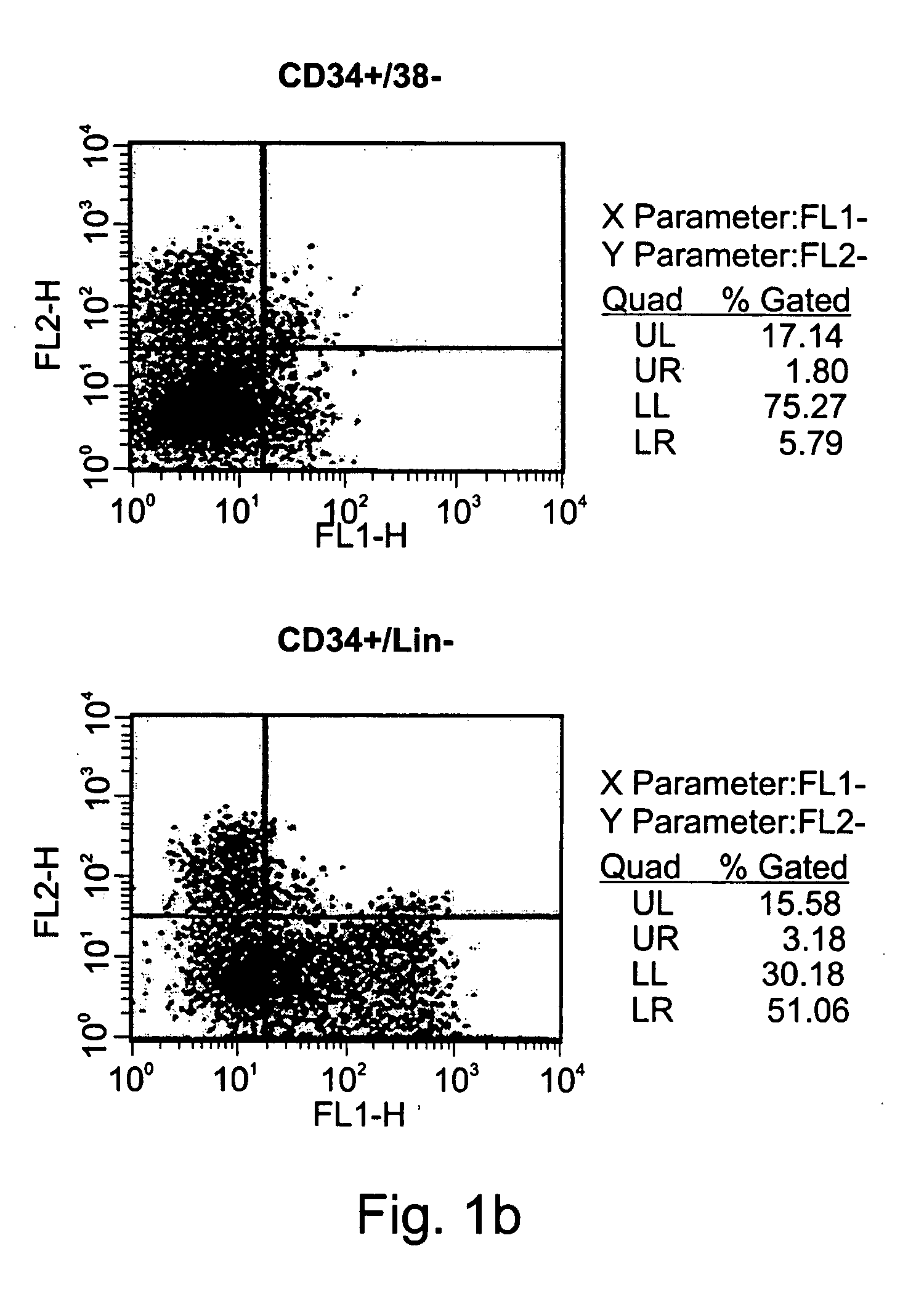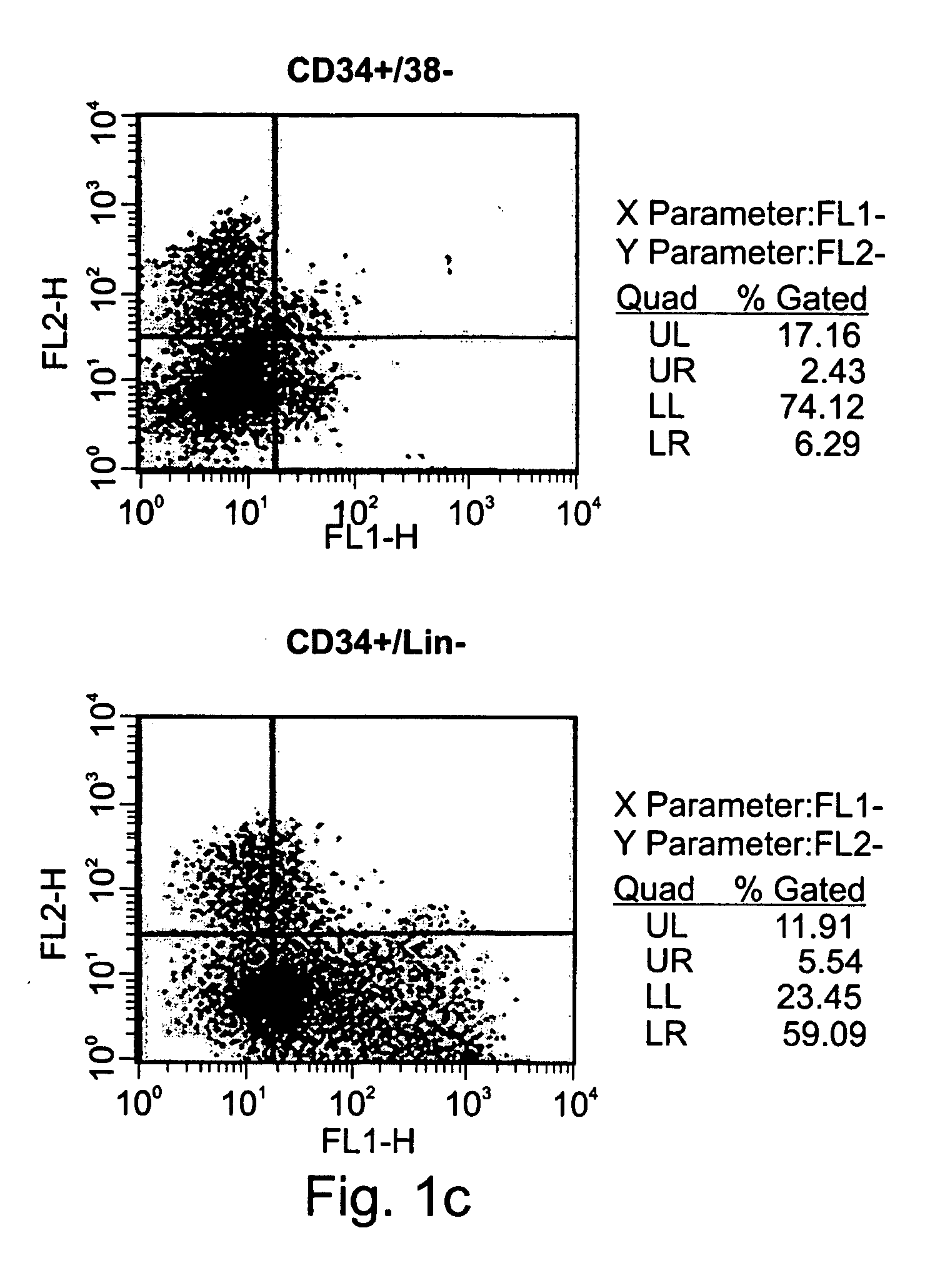Expansion of renewable stem cell populations using modulators of PI 3-kinase
a technology of pi 3-kinase and ex-vivo expansion, which is applied in the field of renewable stem cell expansion, can solve the problems of marked impairment of self-renewal potential, rapid decline of stem cell population activity, and diminished transplantability of cultured cell populations, so as to maximize ex-vivo expansion of various, the effect of downregulating the activity of pi 3-kinas
- Summary
- Abstract
- Description
- Claims
- Application Information
AI Technical Summary
Benefits of technology
Problems solved by technology
Method used
Image
Examples
example 1
RAR-antagonists and Their Use in ex-vivo Hematopoietic Cell Expansion
Material and Experimental Methods
High-affinity Retinoic Acid Receptor Antagonist (RAR) Synthesis:
Synthesis of the RAR Antagonist 4-[[4-(4-ethylphenyl)-2,2-dimethyl-(2H)-thiochomen-6-yl)]-benzoic acid, (AGN 194310):
The RAR antagonist AGN194310 was synthesized according to the procedure described by Johnson (26), with some modification.
Synthesis of 3-(4-methoxyphenylthio)-3-methyl-butyric acid:
A heavy-walled screw-cap tube was charged with 3-methyl-2-butenoic acid (13.86 gm) 3,3-dimethylacrylic acid, (138.4 mmol), 4-methoxythiophenol (143.2 mmol), and piperidine (41.6 mmol) [Aldrich]. The mixture was heated to 105-110° C. for 32 hours, then cooled to room temperature. The reaction mixture was dissolved in ethyl acetate (EtOAc) (700 ml) with stirring, and the resulting solution was washed with 1M aqueous HCl (50 ml×2), water (50 ml), and saturated aqueous NaCl (50 ml). The organic solution was thereafter dr...
example 2
RAR-antagonists and Their Use in ex-vivo Hepatocyte Expansion
Material and Experimental Methods Isolation and Culture of Primary Hepatocytes:
Three intact livers were harvested from 3 week old VLVC female mice (Harlan Laboratories, Jerusalem, Israel), dissected and washed twice with DMEM (Beit Haemek, Israel), incubated with DMEM in the presence 0.05% collagenase for 30 minutes at 37° C., ground and passed through a 200 μm mesh sieve, yielding individual hepatocytes. Cells were washed twice and viability was ascertained with trypan blue. Cells were plated in collagen-coated, 35 mm tissue culture plates at a density of 4-×104 live cells / ml in F12 media (containing 15 mM Hepes, 0.1% glucose, 10 mM sodium bicarbonate, 100 units / ml penicillin-streptomycin, glutamine, 0.5 units / ml insulin, 7.5 m cg / ml hydrocortisone, and 10% fetal bovine serum). Medium was changed after 12 hours, the cells were washed twice with phosphate buffered saline (PBS) and new medium was added. Medium was change...
example 3
RXR and RAR+RXR Antagonists and Their Use in ex-vivo Cell Expansion
Material and Experimental Methods
Synthesis of the RXR antagonist (2E, 4E, 6Z)-7-[3-propoxy-5,6,7,8-tetrahydro-5,5,8,8-tetramethyl-2-naphthalene-2-yl]-3-methylocta-2,4,6-trienoic acid] (LGN 100754):
The synthesis of LGN100754 was based on (i) Canan-Koch et al. J. Med. Chem. 39, 17, 3229-3234 [reaction scheme, page 3231; and (ii) Synthetic protocols from International Application No. PCT / US96 / 14876 (WO 97 / 12853) entitled Dimer-Selective RXR Modulators and Methods for Their Use. All materials were purchased from Ligand Pharmaceuticals Inc.
Synthesis of 6-ethynyl-1,1,4,4-tetramethyl-7-propoxy-1,2,3,4-tetrahydronaphthalene:
Phosphorus oxychloride (0.234 grams, 0.142 ml, 1.52 mmol) was added dropwise to dimethyl formamide (DMF) (4 ml) at room temperature under a nitrogen atmosphere. The solution was stirred for 30 minutes. The 1-(3-propoxy-5,6,7,8-tetrahydro-5,5,8,8,-tetramethylnaphthalen-2-yl) ethanone was added qui...
PUM
| Property | Measurement | Unit |
|---|---|---|
| volume | aaaaa | aaaaa |
| temperature | aaaaa | aaaaa |
| temperature | aaaaa | aaaaa |
Abstract
Description
Claims
Application Information
 Login to View More
Login to View More - R&D
- Intellectual Property
- Life Sciences
- Materials
- Tech Scout
- Unparalleled Data Quality
- Higher Quality Content
- 60% Fewer Hallucinations
Browse by: Latest US Patents, China's latest patents, Technical Efficacy Thesaurus, Application Domain, Technology Topic, Popular Technical Reports.
© 2025 PatSnap. All rights reserved.Legal|Privacy policy|Modern Slavery Act Transparency Statement|Sitemap|About US| Contact US: help@patsnap.com



